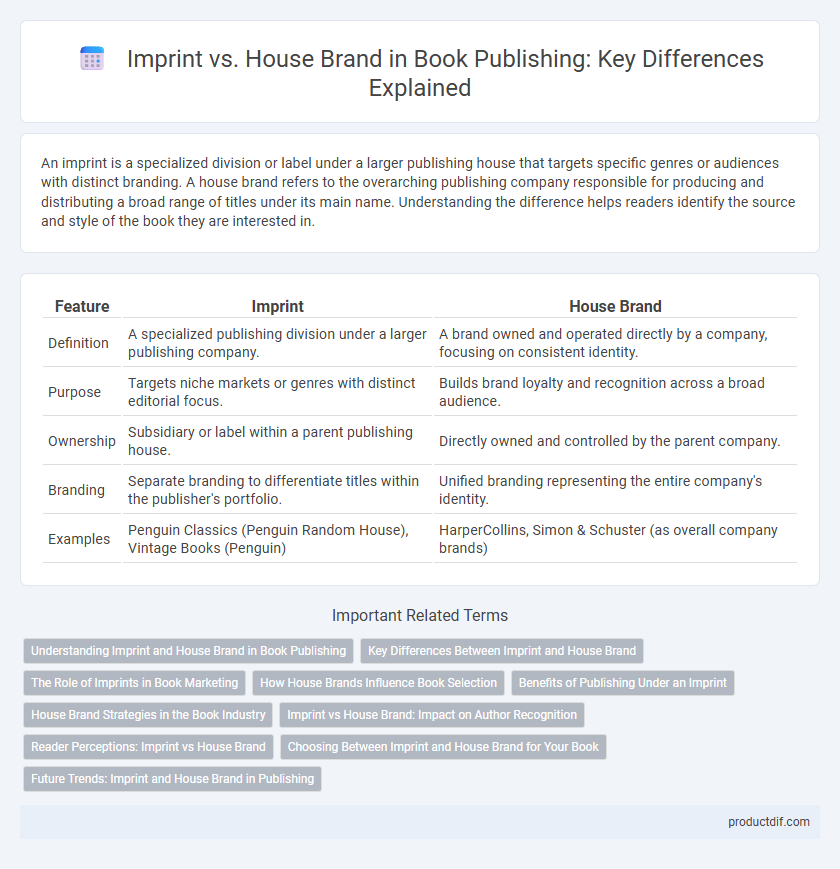An imprint is a specialized division or label under a larger publishing house that targets specific genres or audiences with distinct branding. A house brand refers to the overarching publishing company responsible for producing and distributing a broad range of titles under its main name. Understanding the difference helps readers identify the source and style of the book they are interested in.
Table of Comparison
| Feature | Imprint | House Brand |
|---|---|---|
| Definition | A specialized publishing division under a larger publishing company. | A brand owned and operated directly by a company, focusing on consistent identity. |
| Purpose | Targets niche markets or genres with distinct editorial focus. | Builds brand loyalty and recognition across a broad audience. |
| Ownership | Subsidiary or label within a parent publishing house. | Directly owned and controlled by the parent company. |
| Branding | Separate branding to differentiate titles within the publisher's portfolio. | Unified branding representing the entire company's identity. |
| Examples | Penguin Classics (Penguin Random House), Vintage Books (Penguin) | HarperCollins, Simon & Schuster (as overall company brands) |
Understanding Imprint and House Brand in Book Publishing
Imprint in book publishing refers to a trade name under which a publisher releases works, often targeting specific genres or audiences to create distinct brand identities. A house brand represents the main publishing company itself, encompassing multiple imprints while maintaining overall control and reputation. Understanding the difference helps authors and readers recognize the marketing strategies and editorial focus behind a book's release.
Key Differences Between Imprint and House Brand
An imprint is a trade name or subsidiary brand under a larger publishing house, used to market books to specific audiences or genres, while a house brand refers to the primary brand or publisher itself. Imprints allow publishers like Penguin Random House or HarperCollins to diversify their catalog and target niche markets without creating separate companies. Key differences include ownership structure, branding strategy, and the level of editorial independence offered to imprints compared to the overarching house brand.
The Role of Imprints in Book Marketing
Imprints serve as specialized brand identifiers within larger publishing houses, targeting niche audiences and enhancing market segmentation to boost book sales. By leveraging an imprint's unique reputation and genre focus, publishers can position titles more effectively and build reader loyalty through consistent branding. This strategic use of imprints amplifies visibility and credibility, making them key assets in book marketing campaigns.
How House Brands Influence Book Selection
House brands influence book selection by consolidating diverse imprints under a recognizable corporate identity, making it easier for readers to trust and explore new titles within a familiar brand. These brands often leverage targeted marketing strategies and curated catalogues to align with specific reader preferences, thereby guiding purchasing decisions and bookstore stocking. The presence of a strong house brand can enhance visibility, streamline discovery, and foster loyalty among consumers in competitive publishing markets.
Benefits of Publishing Under an Imprint
Publishing under an imprint offers distinct advantages, such as enhanced brand recognition and targeted market positioning that can attract specific reader demographics. Imprints often benefit from the reputation and established distribution networks of the parent publishing house, facilitating wider reach and increased sales potential. This specialized identity allows authors to align with genres or themes more effectively, boosting discoverability and credibility in their niche.
House Brand Strategies in the Book Industry
House brand strategies in the book industry often involve leveraging established publishing houses' reputations to target niche markets or genre-specific audiences. These strategies include tailored marketing campaigns, curated author selections, and distinct visual branding to differentiate house brands from imprints and enhance consumer trust. By focusing on unique editorial visions and consistent quality standards, publishers strengthen house brand equity and drive long-term sales growth.
Imprint vs House Brand: Impact on Author Recognition
Imprints help authors gain specialized recognition by associating their work with a niche or prestigious publishing division, enhancing credibility and visibility within targeted literary communities. House brands, representing the parent publisher's general identity, may dilute individual author recognition due to broader market positioning and uniform branding. Selecting an imprint can strategically elevate an author's profile by aligning with specific genres or reputations, directly impacting their career growth and audience engagement.
Reader Perceptions: Imprint vs House Brand
Readers often perceive imprints as specialized or curated brands within a larger publishing house, associating them with specific genres or editorial expertise, which can enhance trust and appeal. House brands typically evoke a broader, more uniform identity, sometimes seen as less niche but offering consistent quality and recognition. This distinction influences buying decisions, with imprint enthusiasts seeking tailored content while house brand followers value the reliability of a familiar publisher.
Choosing Between Imprint and House Brand for Your Book
Choosing between an imprint and a house brand for your book depends on your marketing goals and target audience. An imprint offers specialized branding that can enhance credibility within a specific genre, while a house brand provides a broader recognition under the main publisher's established reputation. Consider the reach, audience alignment, and brand identity impact when deciding the best option for your book's publication strategy.
Future Trends: Imprint and House Brand in Publishing
Future trends in publishing indicate a growing convergence between imprints and house brands as publishers leverage both to enhance market reach and author visibility. Imprints will increasingly serve as specialized niches under larger house brands, allowing targeted audience engagement while maintaining cohesive brand identity. Advances in digital marketing and data analytics will enable publishers to customize imprint strategies, optimizing content discovery and reader loyalty across diverse platforms.
Imprint vs House Brand Infographic

 productdif.com
productdif.com